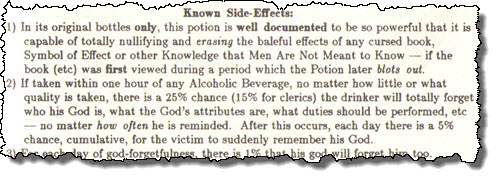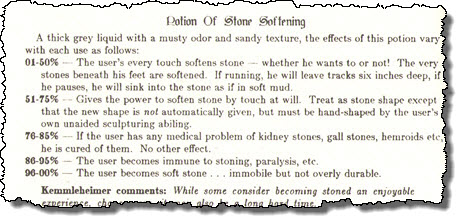Dragon Tree Book Of The Dead V
Delian Book Of The Dead, Part V
Pining For The Fjords
Welcome back to another installment of the long-running (because I’m easily distracted by other things and because work schedules and hospitalized relatives are sucking up the small amount of free time I have to dedicate to a blog with no readers) walkthrough of the early-80s not-quite-Arduin-but-close gaming supplement, the Delian Book Of The Dead. What are we looking at today? Well, we start with doors, and then we move on to whatever’s next, as these things are extemporaneous. I turn the page, I write about what I see, when I think I’ve written enough, I stop.
(I’d love to have something like “Fresh for the new year!” here, but I wrote most of this two weeks ago and just got back to finishing it now. So that last few paragraphs are fresh. The rest is from mid-December.)
When Is A Door Not A Door?
When It’s In An Old-School Dungeon!
Old-school doors existed to be obstacles, not portals. All the way back in the “Underworld & Wilderness Adventures” booklet of Original D&D, E. Gary Gygax issued a number of decrees about doors: They always had to be forced open (even if not locked), and no matter how jammed or hard they were to open, they would automatically slam shut again if not spiked (and there was a 1-in-3 chance of spikes slipping), but the same doors automatically open for monsters, unless players are actively trying to hold them shut. No in-universe explanation for these amusing door physics was provided; it’s just how things worked in Gygax-land. (It’s a good example of the level of abstraction of 0th Edition D&D when it was closer to miniatures wargaming than to roleplaying[1]. It reminds me, oddly, of early arguments from roleplayers when confronted with Magic:The Gathering. “How can you frighten a wall?”, or the jokes from KODT when the characters played Settlers of Cataan:”Why can’t my soldiers fight the bandit?” But I digress. As usual.)
Monsters such as ear-seekers were created specifically to foil players who kept listening at doors. It was originally a no-risk strategy; at worst, you’d hear nothing, at best, you’d gain information, so why not listen at every door? Then, it was mandated by the rules that you had to remove your helmet/coif to listen, and there were special rules to make it dangerous to be caught in melee sans helmet. (And as a counterpoint to the above, we see that the game rapidly evolved to a more simulationist stance as role playing games evolved and it became expected that players would interact with the world more freely.)
Even so, doors could be more than mere physics-defying nests for brain-eating parasites. For instance, they could include, per this supplement:
Kasipotor’s Portal: Decorated with images of gamboling blink dogs and phase spiders (upon close inspection, the images move; upon closer inspection, they are engaging in pratfalls and mishaps – and no, I’m not being funny (“You’re never funny!” shouts the peanut gallery, “I mean, you’ve repeated this self-referential joke a half-dozen times!”), that’s really the description), those walking through this doorway will have any magic items or spells involving teleportation of any sort (including blink, displacement, etc.) fumble or fail. The implication is that the caster can no longer successfully cast such spells, not just that their current load-out is corrupted. Removing this effect requires a high-level remove curse or a wish. Well, that’s one way to end scry/buff/teleport, I guess.
Note: The really baroque font used for headings in the book, which reproduced poorly at the book’s scale, is hard to read; the title is my best guess at the first word.
The Better To Adore You: Hey, folks, blame the pun on the writer. This one is a stone door portraying exciting battle scenes. Anyone trying to open it is pulled into the displayed conflict and must win the battle to escape. If they fail to do so after an hour, they are stuck in the door and visible, as a stone carving, to the other players. It’s possible to extract the stone figure, but it must be done so as not to damage the removed image… the text warns of the dire consequences of using a chisel.
Arms And Armour
Because We Use The British Spelling For Armour But Never Any Other Word
In addition to cursed doors, we must also have cursed, or at least “mixed blessing”, loot. (I note we’re getting further afield from the general theme of tombs/mausoleums/archeology here, relying, I suppose, on the excuse of “Well, there’s doors in tombs, and you find loot in tombs, so…”)
Robux Helm: A “dented” Helm of Telepathy that seems to work normally under test (this is a common trait of cursed items), but which permanently malfunctions the first time it’s used under stress/in combat, so that it constantly reports that all around you are plotting your death. At least one near-TPK resulted from this as the wearer concluded their comrades had been infected with rabies. Yes, it says that.
Note: See my note about Kasipotor’s Portal.
Monkey Sword Trap: An ornate magical sword which is behind some narrow bars – if you grip the sword, you cannot pull your fist back through the bars. Well, no problem, release it and find some clever means to extract it… except it’s a magic sword with an Ego of 19 and it’s lonely. This is rather nasty if the party lacks some means of destroying the cage/bars (which the GM, if they are worthy of the name, will make sure they do).
Hernandeez’ Arrows: Arrows with fletching made from cockatrice feathers, in several variants, all of which are designed to trick the user into touching said fletching in some way. (Would you believe my spellcheck doesn’t recognize “fletching”?)
Arrow of Criticals: A useful item. When it strikes the target, it also projects illusionary red and white circles on the points where they’re most vulnerable to critical hits, giving a +2 to hit and increasing the chance of such hits being criticals by 10%, which means pretty much nothing without knowing which of a half-dozen optional third-party “critical” systems are being used. Also, if fired at a minotaur, it doesn’t provide the targeting mechanism, but it does always hit the target in the eye. A bullseye, if you will. And again, no, that one’s not mine! Blame the writer!
Pasquale’s Crossbow of True Sight: A lot of text, rules, and specifics for what boils down to an anti-magic/anti-illusion crossbow. I won’t type it all. Here’s some of the “side effects”:
So, the good part is that it can detect sneaky illusionists among your enemies. The bad part is that it’s much more likely the caster who created the illusion is long gone and one of your party members will fit into the rather broad categories listed.
Sherlock’s Pistol: A “Victorian” style pistol which fires 50 bullets per round and never needs reloading. However, no matter how it is aimed, when fired, all the bullets divert to the nearest wall to spell out “V R”. Yeah, I don’t get it, either. Too obscure for me.
Poisons
Because At Least That’s Death Related
Here follows an assortment of poisons, lovingly described. I’ll note, again, that the Delian Book Of The Dead is rather distinct from many earlier third party supplements I’ve discussed, in that instead of offering a ten-word snippet to summarize what could be a complex effect, it actually goes into some degree of detail – and it’s obvious, in many cases, the author has had to deal with players encountering the trap/item/relic/potion/whatever and worked out how to respond to their actions.
An Aide Memoire: A potion of forgetfulness, with details as to how much memory is lost per drop, the effects of keeping it in non-standard containers (it loses potency if stored in transparent flasks), and a notation that since you instantly forget taking it, you are likely to take too much, as you never remember that you’ve already drank some. (I recommend writing down “I just took a drop” before taking a drop…). This is another one with “side effects”, the first of which can be very useful.
Andrea’s Filthy Lucre: An item that originated from player ingenuity, this is a coin with a thin gold shell over a deadly poison (type varies), for use when some NPC insists on biting coins to determine if they are counterfeit. When the NPCs in the campaign started using knives to cut the coins instead of biting them, the player switched to using a fine-grained powder that would billow out as soon as the shell was pierced.
The Hair Of The Viper: Perhaps an entry in the long-running “Why did anyone even make that?” category of magic items, this rather bizarre item is a statuette of a snake, and it is labelled “To Cure Poison”. If touched to anyone who is suffering from poison damage, it immediately transforms into a giant snake and attacks the victim, biting, squeezing, etc – after first injecting a poison which paralyzes their vocal cords so they can’t speak. Ah, but the trick is, all the “damage” done is actually healing the effects of the poison, even while the other players try to “rescue” their friend from the killer serpent.
Potion of Stone Softening: Why have reliable, repeatable, effects? How dull!
Regeneration Potion: Another typical “gotcha” type magic item of the era, this vial is usually labelled “for vegetarians only”. It will regenerate fully the first injured flesh it encounters after swallowing. The text gleefully describes what happens if the last thing the imbiber ate was pork of beef, as the fully-restored animal will explode out of their stomach. A second variant, unlabelled, is also described, with the note that players should have learned of the militant vegetarianism (I don’t think “vegan” was a word back when this was produced) of Bernard Wells Posvalsky (the NPC creator of the potion, if that’s a reference to a real or fictional person, it’s over my head) before they encountered this item. It occurs to me one could get use out of this in a manner certain to annoy said NPC. Kill and eat a cow, pour the potion on some scraps of bone and gristle, and get a whole new beast to devour! Just make sure the NPC finds out that’s what you did with it. Heh.
A further note describes the sad fate of a player who carefully stored the potion in his backpack next to some venison jerky, and then fell into a pit, shattering the container…
And we’ll leave off there. I know these are more irregular than usual, which is saying something, but I’m trying to at least trickle out content. As usual, please share with any groups, boards, lists, fora, etc., where it might be appreciated.
[1] Heck, the published rules in the three “Little Brown Books” show signs of being written during a period of rapid evolution and are inconsistent in where they stand between “wargame at 1 figure = 1 individual” scale and “roleplaying game”. The term ‘roleplaying’ (or RPG, or other variant) does not appear in the LBBs. The first time I can find it in a TSR product is in the final issue of Strategic Review. It’s not defined there, just used, in a context where it’s clearly expected to be understood by the readers as defining the genre of game to which D&D belongs. So sometime between 1974 and 1976, the term was coined and spread so rapidly that it quickly became forgotten how new it was!




The ‘V. R.’ is a reference to Sherlock Holmes doing this in one of the stories. ‘V. R.’ stands for ‘Victoria Regina’ ie Queen Victoria.
Now I know! And knowing is half the battle!